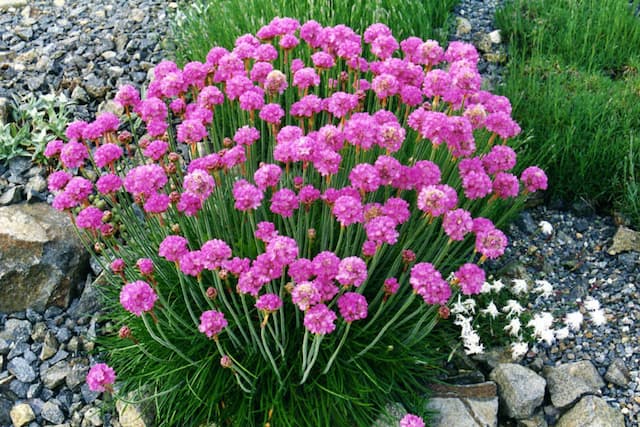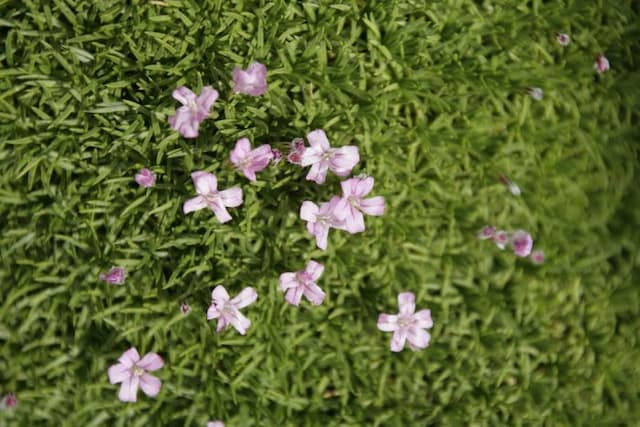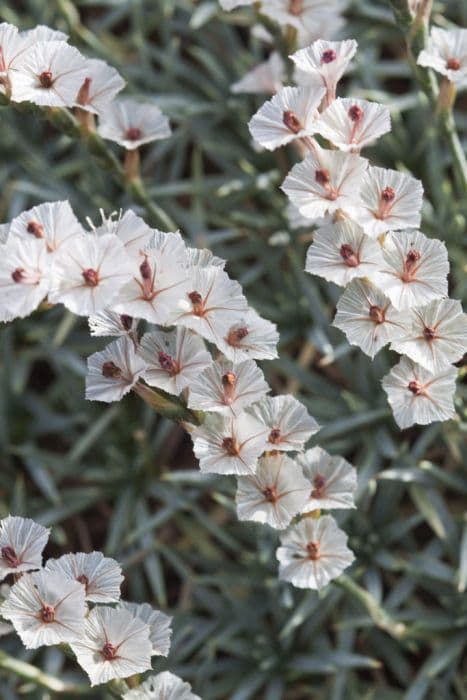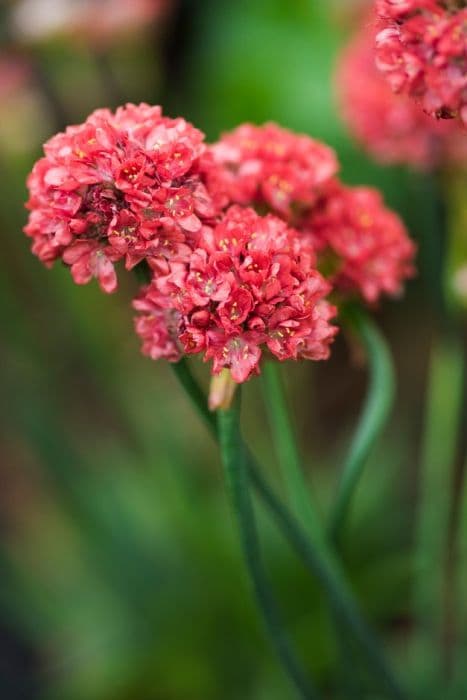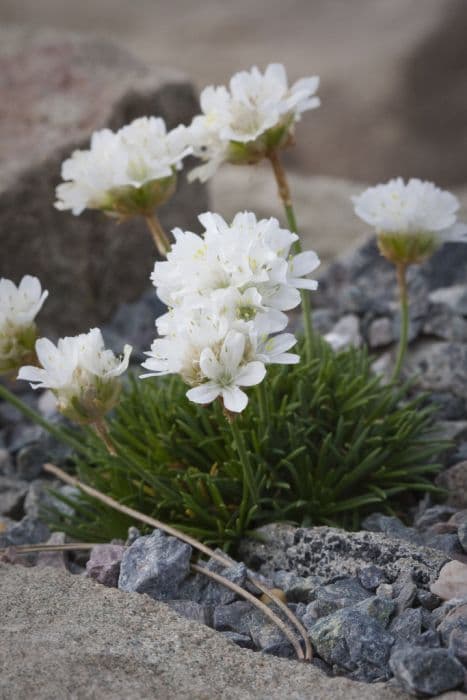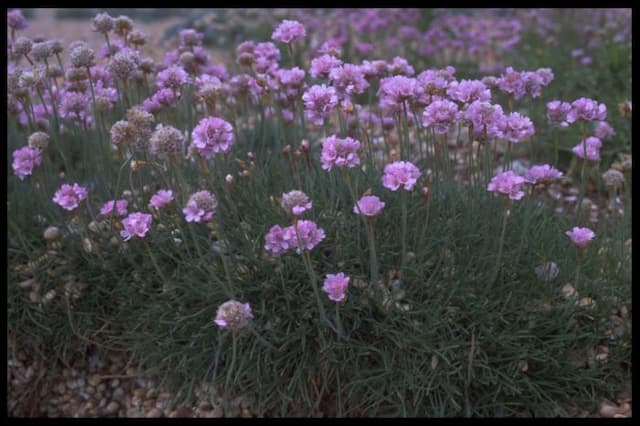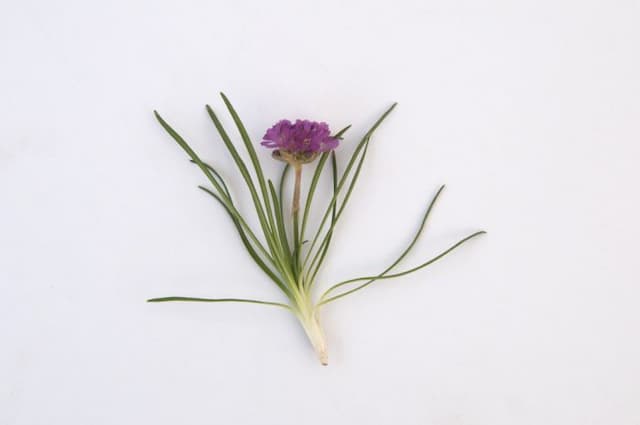Prickly thrift Acantholimon glumaceum
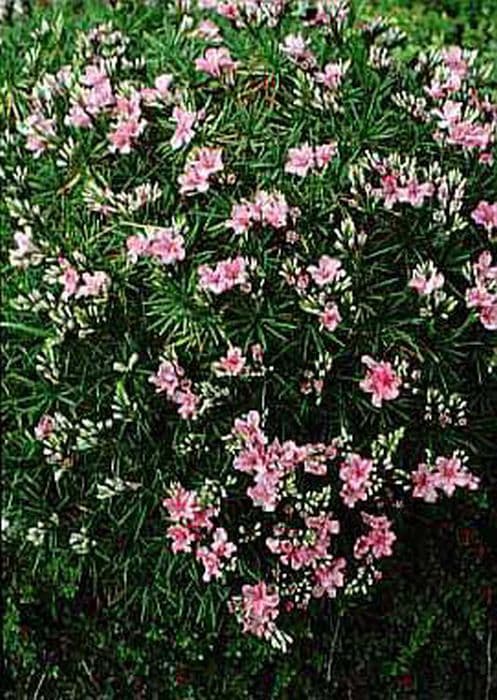
ABOUT
Often known by its common name as Prickly Thrift, Acantholimon glumaceum is a perennial plant recognized for its unique and striking appearance. It is notable for its dense cushions or clumps of foliage that exhibit a distinctive silver-blue or gray-green color. The leaves are small, needle-like, and quite stiff, forming tufts that resemble a spiky cushion or a pincushion. This prickly nature is what likely gives the plant its "prickly" common name. During the flowering season, the Prickly Thrift produces flower spikes that rise from the cushion-like foliage. On these spikes, small, papery bracts are arranged, which may be pink, lavender, or purplish in color, giving a soft contrast to the harshness of the spiny foliage. The actual flowers are nestled within the bracts and are typically of a more vivid hue than the bracts themselves. Overall, the Prickly Thrift has a tough, enduring character, and as an ornamental, it offers a captivating visual texture and color contrast to rock gardens and arid landscape designs, where its resilience to dry conditions and poor soils is greatly valued.
About this plant
 Names
NamesFamily
Plumbaginaceae
Synonyms
Prickly Thrift, Persian Stonecress
Common names
Acantholimon glumaceum subsp. glumaceum, Acantholimon avenaceum, Armeria glumacea, Staticopsis glumacea.
 Toxicity
ToxicityTo humans
Prickly Thrift (Acantholimon glumaceum) is not widely known to be toxic to humans. There is little information available on its toxicity, suggesting that it is not commonly associated with poisoning or adverse health effects upon ingestion. As with any plant, individual sensitivities can vary, and it's always wise to avoid eating plants or plant parts unless they are known to be safe and are prepared correctly.
To pets
Prickly Thrift (Acantholimon glumaceum) is not widely known to be toxic to pets. There is limited information on the plant's effects on domestic animals, indicating that it is not commonly recognized as a poisonous plant. However, caution should still be exercised as individual animals may have different sensitivities, and ingestion of unfamiliar plants can sometimes lead to gastrointestinal upset or other issues. If a pet is known to have ingested part of this plant and is showing symptoms of distress, it is best to consult a veterinarian.
 Characteristics
CharacteristicsLife cycle
Perennials
Foliage type
Evergreen
Color of leaves
Green
Flower color
Pink
Height
1 foot (30 cm)
Spread
1 foot (30 cm)
Plant type
Shrub
Hardiness zones
5
Native area
Turkey
Benefits
 General Benefits
General Benefits- Erosion Control: Acantholimon glumaceum, commonly known as prickly thrift, has a robust root system that helps stabilize the soil and prevent erosion.
- Drought Resistance: Prickly thrift is highly tolerant of dry conditions, making it an excellent choice for xeriscaping and water-wise gardening.
- Low Maintenance: Once established, prickly thrift requires minimal care, as it is adapted to thrive in harsh, rocky environments.
- Aesthetic Appeal: With its distinctive spiky foliage and pink or purple flowers, prickly thrift adds unique visual interest to rock gardens and borders.
- Cold Hardy: It is resilient in cold climates, able to withstand freezing temperatures and frost, which makes it suitable for gardens in cooler regions.
- Pollinator Friendly: The flowers of prickly thrift attract bees and butterflies, supporting local ecosystems and biodiversity.
- Deer Resistant: Its prickly texture makes it less appealing to deer, which can help protect the garden from grazing.
 Medical Properties
Medical PropertiesThis plant is not used for medical purposes.
 Air-purifying Qualities
Air-purifying QualitiesThis plant is not specifically known for air purifying qualities.
 Other Uses
Other Uses- Acantholimon glumaceum, also known as prickly thrift, is used in rock gardens and alpine gardens for its attractive spiny foliage and pink flowers, providing aesthetic interest and textural contrast.
- The plant is suitable for dry, gravel gardens and xeriscaping due to its drought-resistant nature, helping to conserve water and create sustainable landscapes.
- As an ornamental feature, prickly thrift is planted in borders and beds to provide year-round greenery in garden designs that tolerate harsh conditions.
- In floral arranging, the dried flower spikes of prickly thrift can add an unusual and long-lasting element to bouquets and dried floral arrangements.
- Prickly thrift is used in erosion control on slopes and banks as its deep root system helps to stabilize the soil and prevent soil erosion.
- The plant provides habitat and protection for small ground-nesting insects and animals with its dense, spiny foliage offering shelter.
- Prickly thrift can be used in educational gardens to teach about plant adaptations in harsh environments, showcasing its ability to thrive in poor soils with little moisture.
- Enthusiasts of miniature and fairy gardens incorporate Acantholimon glumaceum for its scale and texture, simulating miniature landscapes.
- This plant serves as a low-maintenance groundcover option for areas where other plants struggle to survive, minimizing garden upkeep.
- Prickly thrift is occasionally used as a living mulch, where its foliage helps to suppress weeds and retain soil moisture.
Interesting Facts
 Feng Shui
Feng ShuiPrickly Thrift is not used in Feng Shui practice.
 Zodiac Sign Compitability
Zodiac Sign CompitabilityPrickly Thrift is not used in astrology practice.
 Plant Symbolism
Plant Symbolism- Resilience: Acantholimon glumaceum, commonly known as Prickly Thrift, often grows in harsh, rocky environments, symbolizing the ability to endure and thrive in challenging conditions.
- Protection: The spiny, tough nature of Prickly Thrift reflects a symbol of safeguarding and warding off negative influences, much like its physical form protects it from herbivores and the elements.
- Adaptability: Prickly Thrift's capacity to adapt to poor soils and drought conditions makes it a symbol for flexibility and the ability to succeed despite adversity.
 Water
WaterPrickly Thrift requires minimal watering as it is drought-tolerant once established. Water sparingly, providing about 1 inch of water every 2 to 3 weeks during the growing season. The soil should be allowed to dry out completely between waterings. During the winter months, reduce watering further to prevent root rot, ensuring the plant receives only enough to prevent complete desiccation, which might be as little as a gallon per month depending on the humidity levels of your environment.
 Light
LightPrickly Thrift thrives in full sun conditions, requiring at least 6 hours of direct sunlight daily. The best spot for this plant would be a south-facing location where it can receive ample sunlight throughout the day, ensuring healthy growth and flowering.
 Temperature
TemperaturePrickly Thrift is a hardy plant that can withstand a range of temperatures, from as low as 5°F in the winter to highs around 65°F during the growing season. Ideally, maintain temperatures between 40°F and 60°F for optimal growth. It is important to protect the plant from extreme cold by providing adequate mulch or shelter if temperatures are expected to drop below 5°F.
 Pruning
PruningPrickly Thrift benefits from occasional pruning to remove dead flower spikes and to maintain its compact shape. The best time to prune is in late winter or early spring before new growth begins. Pruning can be done once a year to keep the plant looking tidy and to encourage new growth.
 Cleaning
CleaningAs needed
 Soil
SoilPrickly Thrift (Acantholimon glumaceum) thrives in a well-draining soil mix with low fertility, such as a blend of sand, gravel, and a small amount of compost. The ideal pH for this plant is slightly alkaline, around 7.5 to 8.0. A rock garden mix or alpine plant mix works well for this species.
 Repotting
RepottingPrickly Thrift (Acantholimon glumaceum) typically does not need frequent repotting. It should be repotted once every 2 to 3 years or when it outgrows its pot. The plant prefers to be slightly root-bound, so avoid repotting too often.
 Humidity & Misting
Humidity & MistingPrickly Thrift (Acantholimon glumaceum) prefers dry conditions and does not require high humidity. The best humidity level for this plant is low to moderate, mimicking its natural habitat's arid climate.
 Suitable locations
Suitable locationsIndoor
Ensure bright light and sparse watering for Prickly Thrift.
Outdoor
Plant Prickly Thrift in full sun, well-draining soil.
Hardiness zone
4-8 USDA
 Life cycle
Life cycleAcantholimon glumaceum, commonly known as Prickly Thrift, begins its life cycle as a seed, typically dispersing in the environment through wind or animal movement. Upon finding suitable well-draining soil conditions and enough sunlight, the seed germinates, usually in spring or early summer. The seedling then develops into a rosette of stiff, needle-like leaves, characteristic of this perennial plant's vegetative stage. As it matures, Prickly Thrift will produce flowering stalks with pink to purple flowers between late spring and midsummer, depending on the climate. After pollination, which is often facilitated by insects, the plant produces fruits containing seeds, thus completing its reproductive cycle. The Prickly Thrift is a hardy plant, often surviving harsh winters to continue growing and reproducing in the following seasons.
 Propogation
PropogationPropogation time
Spring-Early Summer
Acantholimon glumaceum, commonly known as Prickly Thrift, is often propagated through seed in late winter or early spring. To propagate Prickly Thrift from seed, surface sow the seeds onto a well-draining seed mix, as light is required for germination. Cover the container with a clear plastic bag or glass to maintain humidity and place it in a bright area without direct sunlight. The temperature should be maintained at around 65-75 degrees Fahrenheit (18-24 degrees Celsius). Water the seeds with a fine mist to keep the soil moist but not waterlogged. Germination can take several weeks, so patience is important. Once the seedlings are large enough to handle, they can be transplanted into individual pots.
